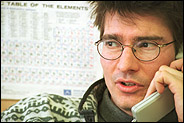On the squishing edge of technology
On the squishing edge of technology McGill University
User Tools (skip):
On the squishing edge of technology
| Physics professor Peter Grütter's research goal is as fine-pointed as his high-tech microscopes: "I want to build and operate instruments at the absolute limits given by nature."
 Physics professor Peter Grütter
Physics professor Peter GrütterPHOTO: Owen Egan |
|
In so doing, he's setting the scientific groundwork for the development of nanoscience, otherwise known as the science of "small stuff," as small as the diametre of an atom.
It's world-leading research for which Grütter was recently awarded a 2001 Steacie Fellowship, awarded by the Natural Sciences and Engineering Research Council (NSERC) and one of Canada's premier science and engineering prizes.
There is currently lots of media buzz about the potential for nanoscale devices in applications related to everything from computing to medicine. But, very little is actually known about the behaviour of matter at the tiniest of levels.
To explain the possible utilization of molecules, for instance, Grutter uses the example of the computer.
"Now computers are made with transistors where the amplification of an electric current is controlled by a voltage. But nanotechnologists dream of using molecules to create a molecular amplifier," he explains. "By squishing the molecule, you regulate its electrical conductivity...The harder you squish the larger the current conducted."
Squishing molecules, however, is no small feat. "I guess that's why I won the prize," chuckles Grutter.
Truth be told, Grutter and his labmates constructed a unique Atomic Force Microscope (AFM) to do the job. It consists of a tiny spring - barely visible to the eye - shaped like a diving board with a tip at the end.
"We may not see angels on the tip," he jokes, "but we can count the number of atoms they are sitting on."
Using the AFM, Grutter can measure the force between the tip and molecule, in this case, carbon 60. "The more pressure you exert, the greater the current," he notes.
"We can press the tip onto the molecule and measure the electric current at the same time. ..The harder you squish, the more current you get."
Before the McGill-adapted AFM, researchers had been severely limited in their ability to measure accurately the diametre of the tip. "They could tell that the pressure had increased but not by how much," says Grutter.
Not that all is simple now. Given the challenges involved - the AFM is housed inside an ultra-high vacuum (to keep out all contamination, such as water from the humidity in the air) and is operated at near absolute zero temperature (-273° C), to keep the molecules from "hopping around" - it can take months to get a single result, notes Dr. Grütter.
When he does get a result, however, there's no ambiguity. "Once everything works, it's so well defined that you get a measurement and you know exactly what it means - there's no room for speculation."
While Grutter's group does the experimental work, Hong Guo, professor of physics, does the theory. "Guo is a world expert in modelling and calculating these things. Together, we try to understand why the molecule is conducting more electricity, and then we can ask the chemists to build molecules which will have an even better effect."
While Grutter's work is largely in the realm of pure science, he also collaborates with several McGill University Health Centre medical researchers. In the area of pain, for instance, he is probing neurons in order to understand what parts of the neuron have more conductance than other parts. "The work may help to develop better drugs that will target the part of the neuron which generates the sensation of pain."
For Grutter, collaborating with researchers in the life sciences, doesn't feel like foreign territory. As he says, "At the nanometre level, the traditional boundaries between physics, chemistry, engineering and the life sciences vanish."

